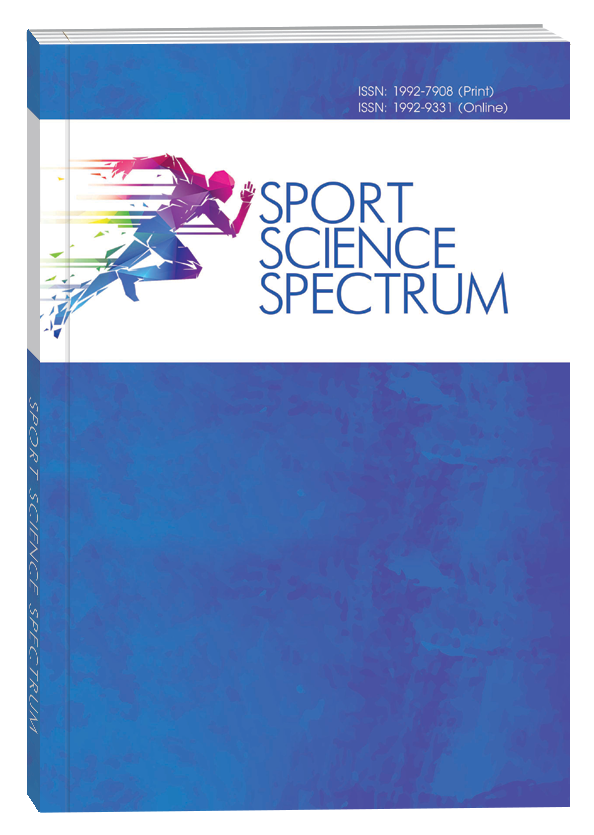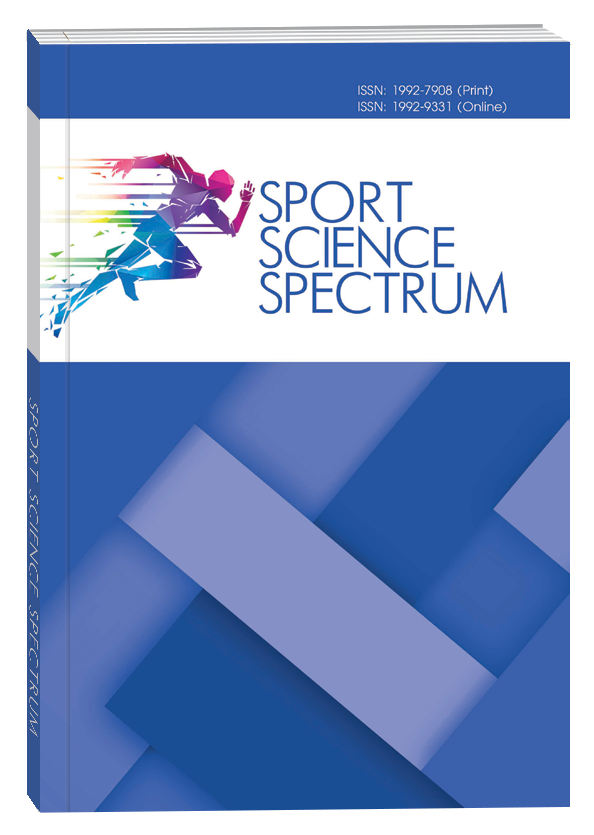PATHS TO IMPROVE THE STRENGTH COMPONENT OF SPECIAL ENDURANCE IN QUALIFIED ATHLETES IN SPORTS DANCING
DOI:
https://doi.org/10.32782/spectrum/2025-2-6Keywords:
sport dances, strength capabilities, functional support of special working capacityAbstract
In sport dance, strength capabilities are an integrated element of special performance. This puts forward special requirements for developing the strength capabilities of sports dancers, and their improvement as an integrated component of functional support of special performance.Objective. To substantiate the ways of improving the strength component of the functional provision of special efficiency of sportsmen-dancers.Methods. Meta-analysis.Results. The power potential of sportsmen-dancers is divided into two interrelated components, each of which has its specific quantitative and qualitative characteristics and requires the formation of a special approach to its improvement. The first component is a special strength potential, which includes indicators of maximal strength, speed and strength qualities and strength endurance. The second component is the power component of functional support of special efficiency, manifested in close interaction with energy, neurogenic reactions, and musculoskeletal apparatus function.Manifestations of special strength and energy capabilities of sportsmen-dancers, as well as the factors determining their effective adaptation to dynamic conditions of competitive activity of sportsmen-dancers, constitute the content basis of target settings of formation of specialized orientation of means of special physical training.Conclusions. Improvement of the power component of special endurance is based on the optimization of the physiological reactivity of the organism and the conditions of its realization. This is associated with an increase in the ability to respond quickly, adequately and fully to training and competitive loads. In conditions of practical activity, it is manifested in the activation of mobilization possibilities of sportsmen-dancers, an increase of phase of stability of working capacity and strengthening of the compensatory function of an organism in conditions of growing fatigue. This affects the nature and degree of adaptation of the organism to training and competitive loads.
References
1. Артем’єва Г. П. Швидкісно-силова витривалість танцюристів акробатичного рок-н-ролу: шляхи вирішення проблеми. Теорія та методика фізичного виховання. 2009. №10. С. 15–18.
2. Олешко В. Г. Підготовка спортсменів в силових видах спорту. ДІА. 2011. 442.
3. Платонов В. М. Сучасна система спортивного тренування. Перша друкарня, 2020. 704 с.
4. Соронович І., Му Ч., Дяченко А., Хом’яченко О. Модельні характеристики швидкої кінетики реакції кардіореспіраторної системи спортсменів-танцюристів. Теорія і методика фізичного виховання і спорту. 2021. №1. С. 67–74.
5. Соронович І., Пілевська В., Дяченко А. Компоненти витривалості в структурі функціональної підготовленості кваліфікованих спортсменів в спортивному танці. Вісник Прикарпатського університету. 2012. № 15. С. 142–150.
6. Соронович І., Хуанг Д., Хом’яченко О., Дяченко А. Специфічні характеристики стійкості функціонального забезпечення спеціальної працездатності спортсменів-танцівників. Спортивна наука та здоров’я людини. 2022. №1(7). C. 98–110.
7. Тодорова В., Сосіна В.. Розвиток силових якостей у танцюристів засобами хореографічної підготовки. Наука і освіта. 2020. № 4. С. 9–17.
8. Хом’яченко О., Соронович І. Теоретико-методичне обґрунтування конверсії функціональної підготовленості спортсменів у спортивних танцях. Теорія і методика фізичного виховання і спорту. 2022. №2. С. 37–43.
9. Alizadeh S., Daneshjoo A., Zahiri A., Anvar S., Goudini R., Hicks J., Konrad A., Behm D. Resistance Training Induces Improvements in Range of Motion: A Systematic Review and Meta-Analysis. Sports Med. 2023. Vol. 53(3). P. 707–722. doi: 10.1007/s40279-022-01804
10. Benavente C., Schoenfeld B., Padial P., Feriche B. Efficacy of resistance training in hypoxia on muscle hypertrophy and strength development: a sys- tematic review with meta-analysis. Sci Rep. 2023. Vol. 13(1). 3676. doi: 10.1038/s41598-023-30808-4
11. Bompa T. O., Buzzichelli C. Periodization: Theory and Methodology of Training. Sixth ed. Human Kinetics. 2018. 392 p.
12. Chen J., Zhou D., Gong D., Wu S. A study on the impact of systematic desensitization training on competitive anxiety among Latin dance athletes. Front Psychol. 2024. Vol. 9(15). doi: https://doi.org/10.3389/fpsyg.2024.1371501.
13. Diachenko A., Guo P. et al. Neurohumoral Components of Rapid Reaction Kinetics of the Cardio-Respiratory System of Kayakers. Sport Mont. 2021. Vol. 19(S2). P. 29–33. doi 10.26773/smj.210906
14. Fekri-Kourabbaslou V., Shams S., Amani-Shalamzari S. Effect of different recovery modes during resistance training with blood flow restriction on hor- monal levels and performance in young men: a randomized controlled trial. BMC Sports Sci Med Rehabil. 2022. Vol. 14(1):47. doi: 10.1186/s13102-022-00442-0
15. Kiliç M., Nalbant S. S. The effect of latin dance on dynamic balance. Gait Posture. 2022. Vol. 92. 264–270. doi: 10.1016/j.gaitpost.2021.11.037.
16. Maroto-Izquierdo S., Martín-Rivera F., Nosaka K., Beato M., González-Gallego J., Paz J. Effects of submaximal and supramaximal accentuated eccentric loading on mass and function. Front Physiol. 2023. Vol. 14:1176835. doi: 10.3389/fphys.2023.1176835
17. Mu C., Soronovych I., Diachenko A. et al. The Characteristics of Physical Fitness Related to Athletic Performance of Male and Female Sport Dancers. Sport Mont. 2021. № 19(S2). P. 125–130. doi: 10.26773/smj.210921
18. Myrholt R., Solberg P., Pettersen H., Seynnes O., Paulsen G. Effects of Low- Versus High-Velocity-Loss Thresholds With Similar Training Volume on Maximal Strength and Hypertrophy in Highly Trained Individuals. Int J Sports Physiol Perform. 2023. Vol. 18(4). Р. 368–377. doi: 10.1123/ijspp.2022-0161
19. Podrihalo O., Xiaohong G., Mulyk V., Podrigalo L., Galashko M., Sokol K., Jagiello W. Priority scientific areas in sports dances research: the analysis of the scientific resources of Web of Science Core Collection. Physical Education of Students. 2022. Vol. 26(5). 207–23
20. Schoenfeld B., Androulakis-Korakakis P., Piñero A., Burke R., Coleman M., Mohan A., Escalante G., Rukstela A., Campbell B., Helms E. Alterations in Measures of Body Composition, Neuromuscular Performance, Hormonal Levels, Physiological Adaptations, and Psychometric Outcomes during Preparation for Physique Competition: A Systematic Review of Case Studies. J Funct Morphol Kinesiol. 2023. Vol. 8(2), 59.
21. Smilios I., Myrkos A., Zafeiridis A., Toubekis A., Spassis A., Tokmakidis S. P. The Effects of Recovery Duration During High-Intensity Interval Exercise on Time Spent at High Rates of Oxygen Consumption, Oxygen Kinetics, and Blood Lactate. J Strength Cond Res. 2018. Vol. 32(8), 2183-9. doi: 10.1519/JSC.0000000000001904
22. Wanke E. M., Mörl-Kreitschmann M., Holzgreve F., Groneberg D., Ohlendorf D. Upper body posture in Latin American dancers: a quantitative cross-sec- tional study comparing different postures. BMC Sports Sci Med Rehabil. 2023. Vol. 25:15(1), 66. doi: 10.1186/s13102-023-00672-w.
23. Wyon M., Allard G. Periodization: A Framework for Dance Training. Bloomsbury Publishing Plc. 2022.
24. Wilmore J. H. Costil D. L. Physiology of Sports. Olympic Literature. 2001. 506 s.





